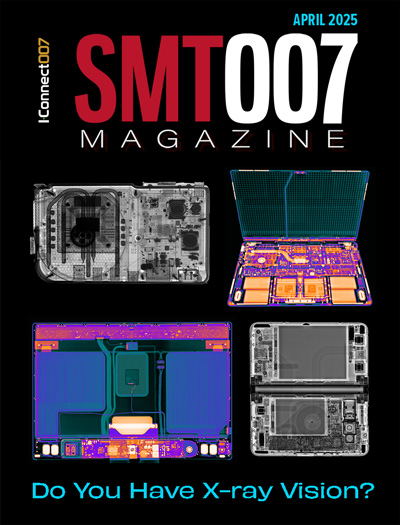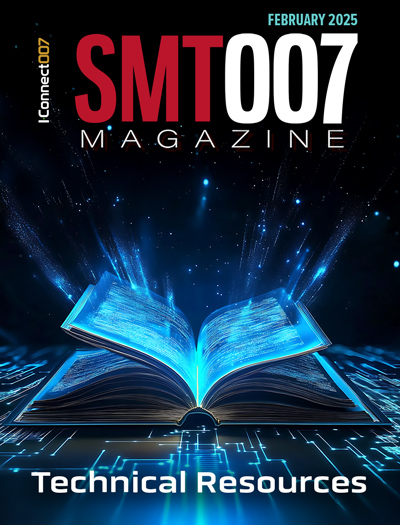-

-
News
News Highlights
- Books
Featured Books
- smt007 Magazine
Latest Issues
Current Issue
Do You Have X-ray Vision?
Has X-ray’s time finally come in electronics manufacturing? Join us in this issue of SMT007 Magazine, where we answer this question and others to bring more efficiency to your bottom line.

IPC APEX EXPO 2025: A Preview
It’s that time again. If you’re going to Anaheim for IPC APEX EXPO 2025, we’ll see you there. In the meantime, consider this issue of SMT007 Magazine to be your golden ticket to planning the show.

Technical Resources
Key industry organizations–all with knowledge sharing as a part of their mission–share their technical repositories in this issue of SMT007 Magazine. Where can you find information critical to your work? Odds are, right here.
- Articles
- Columns
Search Console
- Links
- Media kit
||| MENU - smt007 Magazine
NASA Transmits Hip-Hop Song to Deep Space for First Time
July 16, 2024 | NASAEstimated reading time: 2 minutes
Lyrics for Missy Elliot’s song “The Rain (Supa Dupa Fly)” were transmitted from the DSN’s Goldstone complex to Venus, about 158 million miles (254 million kilometers) away.
The stars above and on Earth aligned as an inspirational message and lyrics from the song “The Rain (Supa Dupa Fly)” by hip-hop artist Missy Elliott were beamed to Venus via NASA’s DSN (Deep Space Network). The agency’s Jet Propulsion Laboratory in Southern California sent the transmission at 10:05 a.m. PDT on Friday, July 12.
As the largest and most sensitive telecommunication service of NASA’s Space Communications and Navigation (SCaN) program, the DSN has an array of giant radio antennas that allow missions to track, send commands, and receive scientific data from spacecraft venturing to the Moon and beyond. To date, the system has transmitted only one other song into space, making the transmission of Elliott’s song a first for hip-hop and NASA.
“Both space exploration and Missy Elliott’s art have been about pushing boundaries,” said Brittany Brown, director, Digital and Technology Division, Office of Communications at NASA Headquarters in Washington, who initially pitched ideas to Missy’s team to collaborate with the agency. “Missy has a track record of infusing space-centric storytelling and futuristic visuals in her music videos, so the opportunity to collaborate on something out of this world is truly fitting.”
The song traveled about 158 million miles (254 million kilometers) from Earth to Venus — the artist’s favorite planet. Transmitted at the speed of light, the radio frequency signal took nearly 14 minutes to reach the planet. The transmission was made by the 34-meter (112-foot) wide Deep Space Station 13 (DSS-13) radio dish antenna, located at the DSN’s Goldstone Deep Space Communications Complex, near Barstow in California. Coincidentally, the DSS-13 also is nicknamed Venus.
Elliott’s music career started more than 30 years ago, and the DSN has been communicating with spacecraft for over 60 years. Now, thanks to the network, Elliott’s music has traveled far beyond her Earth-bound fans to a different world.
“I still can’t believe I’m going out of this world with NASA through the Deep Space Network when ‘The Rain (Supa Dupa Fly)’ becomes the first ever hip-hop song to transmit to space!” said Elliott. “I chose Venus because it symbolizes strength, beauty, and empowerment and I am so humbled to have the opportunity to share my art and my message with the universe!”
Two NASA missions, selected in 2021, will explore Venus and send data back to Earth using the DSN. DAVINCI (Deep Atmosphere Venus Investigation of Noble gases, Chemistry, and Imaging), led out of NASA’s Goddard Space Flight Center in Greenbelt, Maryland, is slated to launch no earlier than 2029. The VERITAS (Venus Emissivity, Radio Science, InSAR, Topography, and Spectroscopy), launching no earlier than 2031, is lead out of JPL. NASA and the DSN are also partnering with the European Space Agency’s Venus mission, Envision. A team at JPL is developing the spacecraft’s Venus Synthetic Aperture Radar (VenSAR).
In continuous operations since 1963, NASA SCaN’s DSN is composed of three complexes spaced equidistant from each other — approximately 120 degrees apart in longitude — around the planet. The ground stations are in Goldstone in California, Madrid, and Canberra in Australia.
The DSN is managed by JPL for the SCaN program within the Space Operations Mission Directorate, based at NASA Headquarters.
Suggested Items
FTG Announces Q1 2025 Financial Results
04/10/2025 | Firan Technology Group CorporationIn Q1 2025, the Corporation grew through acquisition and organically. FTG is strategically investing its capital in ways that will drive increased shareholder returns for the future in both the near term and long term. The company's achievements in Q1 2025 demonstrate this commitment, laying a strong foundation for future growth.
Rocket Lab Expands Satellite Solutions with Customizable Solar Arrays
04/10/2025 | BUSINESS WIRERocket Lab USA, Inc., a global leader in launch services and space systems, today introduced the Company’s family of customizable, next-generation solar arrays, Standardized Array (STARRAY), to meet the diverse power needs of satellites operating in any orbital conditions.
Eighth Lockheed Martin-Built GPS III Satellite Arrives in Florida for Final Launch Preparations
04/08/2025 | Lockheed MartinThe eighth Lockheed Martin-designed and -built Global Positioning System (GPS) III space vehicle (SV08) for the U.S. Space Force has successfully arrived in Florida to begin final preparations for a launch in late spring 2025.
Real Time with... IPC APEX EXPO 2025: AI-powered First Article Inspections from GroundControl
04/08/2025 | Real Time with...IPC APEX EXPOMahul Shah introduces GroundControl, CUI-compliant cloud software designed for EMS providers to streamline quality inspection processes in aerospace. This software automates report generation, significantly reducing the time spent on manual data entry and minimizing errors. By incorporating AI, GroundControl enhances efficiency and accuracy, allowing users to access the platform online, book demos, and try it for free.
New Splitting Method: Fraunhofer IIS Brings Satellites Into The 5G Era
04/04/2025 | Fraunhofer IAFGlobal mobile communications that reliably reach every remote region, leaving no gaps on the map? Satellites play a key role in achieving this goal. In the future, however, not all satellites will be powerful enough to act as complete base stations.


